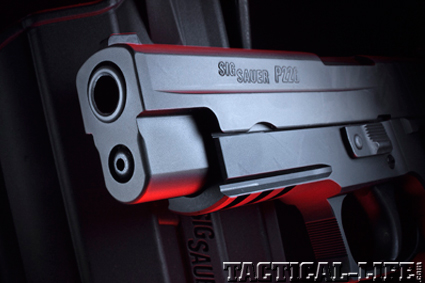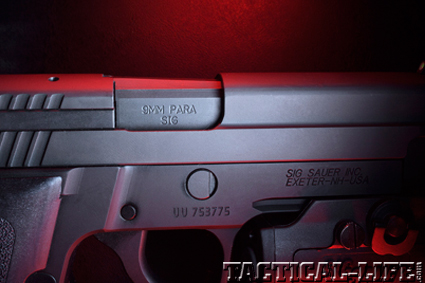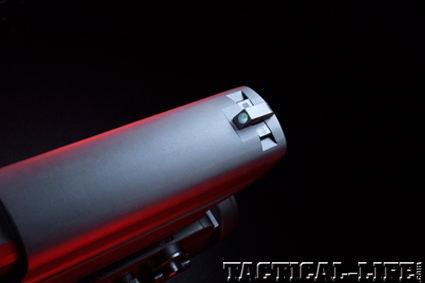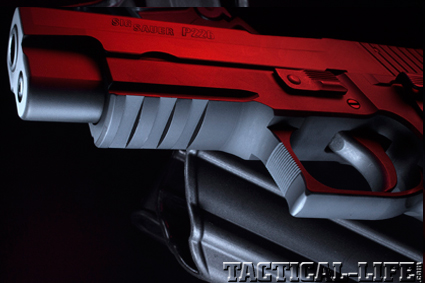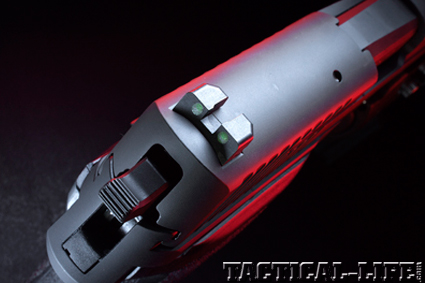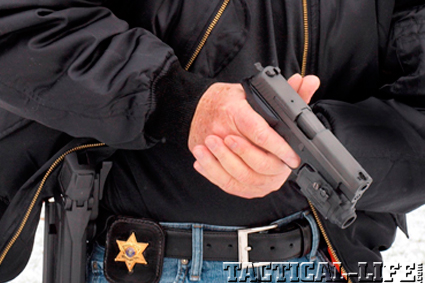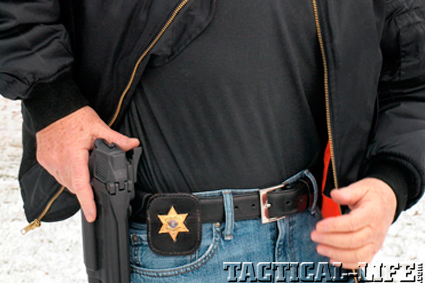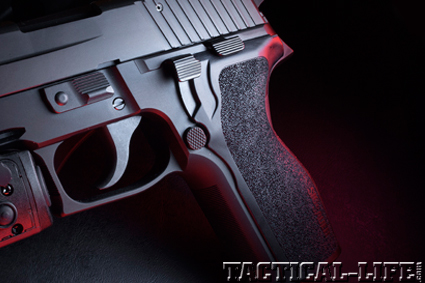Sometimes you really have to thank the U.S. government for deciding to replace the Colt Model 1911 back in 1985. Not that it was necessarily the right decision, but more so that the rush to build a suitable replacement brought about significant advances in modern semi-auto pistol designs from many of the world’s leading armsmakers. When the U.S. went shopping back in 1984, the two top contenders to replace the M1911 were Beretta and Sig Sauer. And while the Beretta Model 92F (M9) might have received the final nod from Uncle Sam, the world got the Sig P226!
After 1985, individual branches of the U.S. military remained divided on the decision to drop the M1911, and the .45 ACP remained in use with special operations and select federal agencies, eventually resulting in the Joint Combat Pistol (JCP) Program in 2005. The JCP brought about a new round of developments from several armsmakers anticipating a possible return of the military to a modernized .45 ACP semi-auto. Ironically, the JCP (and the short-lived Combat Pistol Program that followed) were suspended when it was decided the M9 should be retained (and the Army dropped its participation in the program), but once again the world got a wealth of new developments in semi-auto pistols, some of which evolved from the Sig P226. As for the original, it continues to be improved and remains a staple with law enforcement and military around the world, including U.S. federal agencies and the Navy SEALs.
Gun Details
Advertisement — Continue Reading Below
Despite the Beretta having replaced the M1911 as this nation’s standard-issue sidearm almost 30 years ago, the Sig Sauer family of 9mm, .357 SIG and .40 S&W pistols has become the most commonly issued brand of sidearm for U.S. government and military agencies. It is also commonly found in the holsters of domestic law enforcement agencies. As one of the most established self-defense handguns in use today, there are now 21 different versions of the P226 designed for specific requirements, ranging from tactical models with threaded barrels and Flat Dark Earth finishes, to deluxe stainless steel and engraved versions, double-action-only (DAO) and single-action-only (SAO) variants and even a .22 LR model.
Since 2011, a number of minor improvements have been incorporated into the P226, particularly in the grip design. Since the Sig does not have interchangeable backstrap panels to accommodate different hand sizes, the depth of the backstrap has been reduced by 0.15 inches in line with the trigger, the grip contour redesigned to trim down circumference and the trigger face moved 0.4 inches back. The combined changes deliver a total reduction of 0.55 inches, a real plus for operators with small- to medium-sized hands and no detriment to those with larger hands.
Another important change is in the trigger design. The P226 comes standard with a short-reset trigger. This used to be an armorer-installed option designed to reduce the length of travel required to reset the trigger by 60 percent. This provides an almost instantaneous reset for quick follow-up shots.
The exceptional ergonomics and balance of the P226 make this full-sized pistol easier to handle than many of its contemporaries. Since it is also designed to chamber hard-hitting .357 SIG and .40 S&W rounds, the gun’s size (7.7 inches in length) and weight (34 ounces unloaded) contribute to reducing felt recoil with 9mm ammunition. The pistol’s longer 4.4-inch barrel also factors in for improved ballistic performance and better accuracy.
Advertisement — Continue Reading Below
Among standard features that make the P226 desirable as a duty gun are a large, easy-to-operate slide release, an equally large and easy to manipulate decocking lever (which allows the gun to be safely carried with the hammer down on a loaded chamber) and a deeply checkered magazine release that drops empty mags smoothly out of the grip frame for effortless one-handed operation. The P226 is also very easy to field-strip. Taken together, these features makes the gun intuitive to handle, combining conventional safety mechanisms and ease of use with a traditional hammer-fired, semi-auto design. Call it old fashioned, but I like having the option of cocking and decocking my handgun with a chambered round. Additionally, there is no magazine disconnect, so the P226 will fire with the magazine removed. And by using a decocker, the gun has no need for a manual safety, enabling the gun to be brought into use more efficiently.
In addition to three calibers, the P226 offers a choice of DA/SA, DAO or double-action-Kellerman (DAK) operating systems. The DAK is designed to provide a light, double-action trigger pull similar to that of a finely tuned DA revolver. The P226, as with other Sig models, operates using a variation of the locked-breech, short-recoil method pioneered by John M. Browning in the early 20th century.
The example I received for testing was the 9mm P226 DA/SA model carried by federal agents, Navy SEALs, the Ohio State Highway Patrol and the Michigan State Police, among others. In particular, it was the P226 TacPac model that comes standard with an STL-900L light/laser, a Level 2 security light/laser Roto holster, a speedloader and a spare magazine (for two magazines in total). The gun also came equipped with SIGLITE night sights, which are steel in construction and dovetailed for ease of adjustment or replacement. The rear sight is of particular note for law enforcement and military operators, as it is slightly raised and angled at the base for a sturdy edge that can be used to cycle the slide one-handed in an emergency. The steel construction ensures that the sight won’t break off if pushed hard against a flat edge.
Advertisement — Continue Reading Below
The injection-molded Roto holster is the first offered by Sig Sauer that accommodates the P226 with the STL-900L light/laser attached. The TacPac I tested is the P226R, which has a suggested retail of $1,215—the base price for every TacPac, with the exception of the SP2022, which sells for $710. The TacPac-L is available for the Sig P220, P226, P229 and SP2022 models as well as Sig 1911 models with or without Picatinny rails.
Range Test
There are several features on the P226 that become immediately apparent while testing the gun on the range. The first is the ease with which the slide can be cycled to chamber a round or clear the action. The effort required is less than almost any other semi-auto in this size and weight class in my opinion. The same applies to the ease with which the slide release operates, requiring only modest effort. Third is the decocker, which can be easily thumbed downward to put the P226 in a safe condition. Another benefit of the decocker is that the operator has the option of either firing the first shot in DA mode or re-cocking the hammer to fire in SA. All three features make the P226 a great gun to handle in the field, because they mitigate the small issues than can cost you precious seconds when every second counts.
Advertisement — Continue Reading Below
The one-piece, injection-molded grips have rough stippling on the backstrap and side panels that is easy on the hand while providing for a very secure hold. In addition, there are fine 30-lines-per-inch (lpi) serrations cut into the frontstrap. DA trigger pulls on my test sample averaged 9.9 pounds; SA pulls average 5.21 pounds. Trigger take-up (travel) on the P226 when fired in DA mode measured 0.94 inches with no discernable change in trigger pull effort (stacking). The SA take-up measured 0.44 inches with zero overtravel. With Sig’s short-reset trigger, the distance to reset measured an equal 0.44 inches. All in all, the P226 has a highly effective trigger system that, with practice, can work to your advantage during rapid fire or when engaging multiple threats.
The ammunition chosen for the test was a combination of three leading defense brands in differing bullet weights: Speer Gold Dot 115-grain GDHP Personal Protection, Federal Premium 124-grain Hydra-Shok JHP Personal Defense and Hornady 135-grain FlexLock Critical Duty. I tested the 4.4-inch-barreled P226 from a distance of 25 yards off-hand using a two-handed hold and a Weaver stance.
The P226 is a very easy pistol to fire, and it balances so well in the hand that it feels smaller and lighter than it actually is. The gun was supplied with 10-round magazines (15-round magazines are also available). The white-dot sights were right on at 25 yards, and all three brands of ammo grouped fairly closely, with the average five-shot strings ranging from 1.25 to 1.5 inches. Recoil was roughly equal with all three loads tested, with rounds traveling at a swift 1,250 feet per second (fps) with Speer 115-grain GDHP, 1,125 fps for 124-grain Federal Hydra-Shok and 1,085 fps for the heavier 135-grain Hornady Critical Duty. None of the ammunition suffered jams or failures to feed, and the P226 functioned flawlessly.
Advertisement — Continue Reading Below
As a sidearm for law enforcement duty use, the Sig Sauer P226 is very hard to beat for ease of operation, standard features, safety and handling capability in my opinion. On top of the merits of the pistol itself, the P226 TacPac system contains the best of all worlds—in one convenient package. For more information, visit sigsauer.com or call 603-772-2302.
